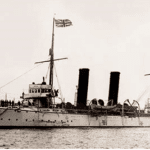The wreck of the HMS Sybille
On 17 January 1901 at 10 o’clock, the sound of the recall signal being fired from the HMS Doris was heard. This was in order to ready to head to the rescue of HMS Sybille which had reported being run aground just south of Lamberts Bay. The HMS Sybille was a twin-screw, second-class cruiser that weighed 3400 tons. It had been built in 1890 by R. Stephenson of Newcastle-on-Tyne.
The Sybille arrived in Simon’s Town from England on Saturday 12 January 1901, where she was loaded up and put to sea again on Monday 14 January, headed for Lamberts Bay. While laid over in the bay the weather turned rather suddenly with the North West wind becoming a gale. There was little protection at Lamberts Bay for a ship the size of the Sybille and the captain decided to put to sea at 10 pm on the night of 15 January. The Sybille steamed out of the bay into increasingly rough seas.
At around 2 a.m. the next morning, the weather had somewhat calmed down, The Sybille proceeded to steam back to Lamberts Bay. However, the southerly set of the current had pushed the vessel some six miles south of what they believed their position to be. At 4.30 on the morning of 16 January, the Sybille struck a reef near the farm at Steenboksfontein, a few kilometres south of Lamberts Bay.
The order was given the reverse the engines to try and get her off. It became clear that the vessel was stuck and was filling fast, the watertight doors were shut, and preparations were made to abandon the ship.
. The last man to leave the ship was Lt. Holland and the only casualty was a nineteen-year-old ordinary seaman, who had sustained fatal internal injuries when he was swept across the deck and was crushed against one of the vessel’s 4.7-inch guns. He was later buried in the area and his grave can be seen in the small cemetery in Lamberts Bay.


